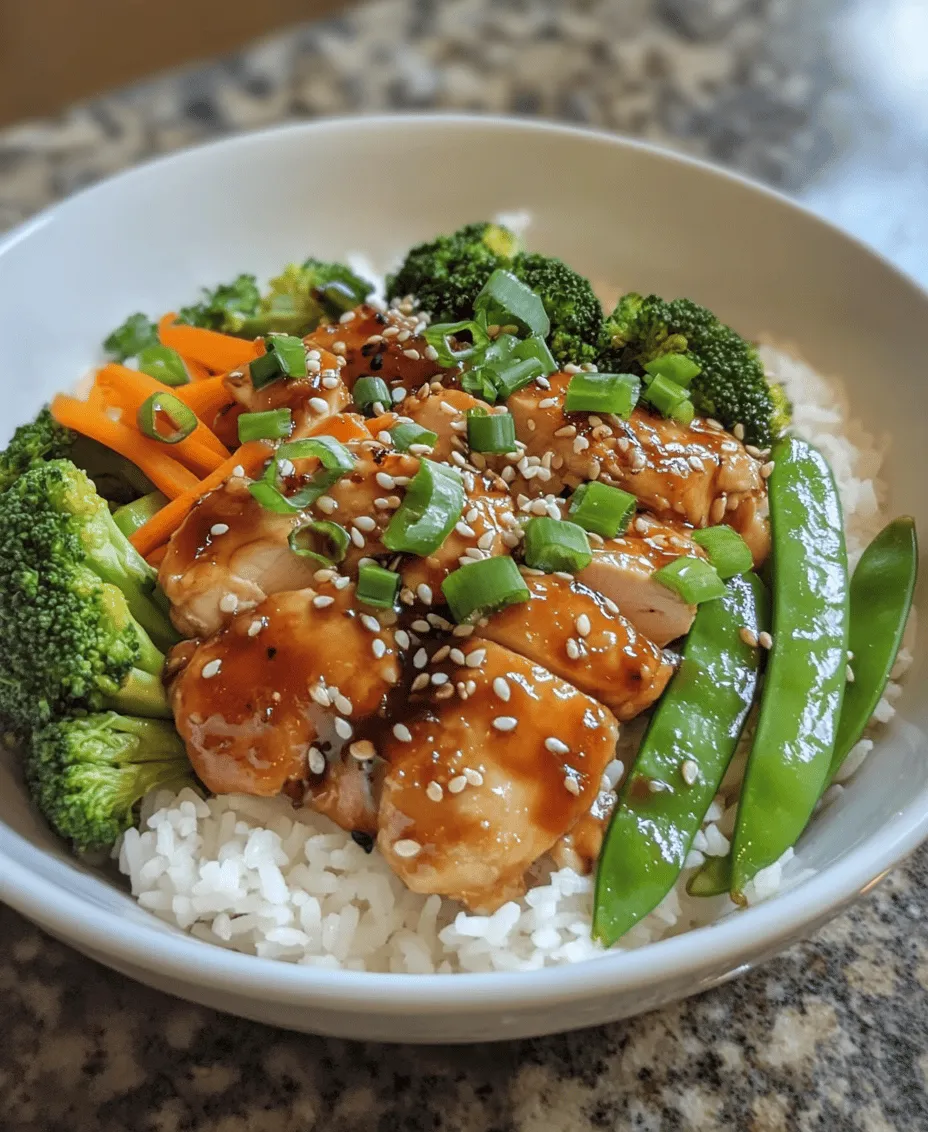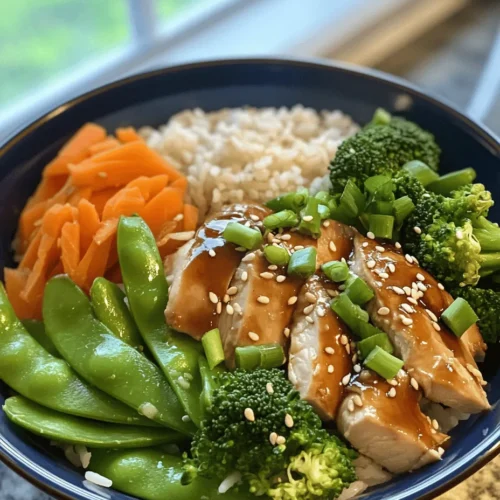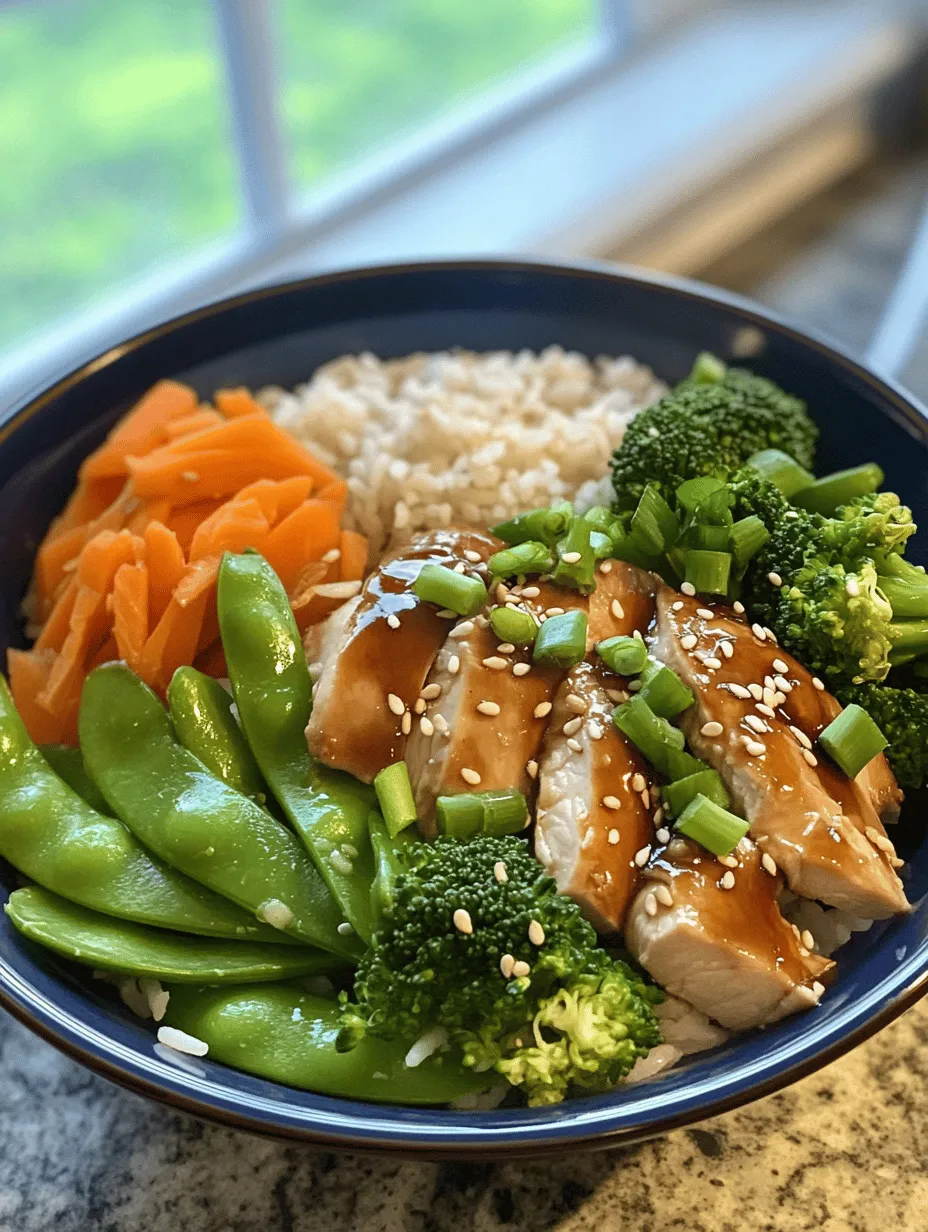Introduction
The Teriyaki Chicken Rice Bowl is a beloved dish that combines tender, flavorful chicken with a vibrant assortment of vegetables, all served over a bed of fluffy rice. Originating from Japan, teriyaki translates to “grilled” or “broiled” in reference to the cooking method used for the chicken, while the term also encompasses the rich, glossy sauce that defines this dish. The origins of teriyaki can be traced back to the 17th century, when Japanese cooks began to experiment with grilling meat and glazing it with a sweet soy-based sauce. Today, the Teriyaki Chicken Rice Bowl has transcended its traditional roots, becoming a staple in kitchens around the world.
One of the reasons this dish is so popular is its balance of flavors and nutrition. The combination of protein from the chicken, carbohydrates from the rice, and a variety of vitamins and minerals from the vegetables creates a well-rounded meal that is as satisfying as it is nourishing. In our fast-paced world, where convenience often takes precedence over health, the Teriyaki Chicken Rice Bowl serves as a delicious reminder of the importance of balanced meals. This dish is not only healthy but also remarkably simple to prepare, making it an excellent choice for home cooks of all skill levels.
In this article, we will guide you through the process of creating your very own Teriyaki Chicken Rice Bowl. From understanding the components that make this dish shine to step-by-step cooking instructions, you will be well-equipped to bring this culinary delight to your table. Let’s dive in!
Understanding Teriyaki Sauce
To truly appreciate the Teriyaki Chicken Rice Bowl, it is essential to understand the role of teriyaki sauce in the dish. Teriyaki sauce is a sweet and savory glaze made primarily from soy sauce, mirin, and sugar. The origins of teriyaki sauce can be traced back to Japan, where it was traditionally used as a marinade and glaze for grilled meats, especially fish and chicken. Over time, it has evolved into a versatile sauce that can be used in a variety of culinary applications.
Key Ingredients of Teriyaki Sauce
1. Soy Sauce: The backbone of teriyaki sauce, soy sauce provides a salty umami flavor that elevates the taste of the chicken. There are different types of soy sauce available, including light, dark, and tamari, each with its own flavor profile. For a classic teriyaki flavor, a good-quality light soy sauce is typically recommended.
2. Mirin: This sweet Japanese rice wine adds depth and a hint of sweetness to the sauce. Mirin is essential for achieving the authentic flavor of teriyaki. If you cannot find mirin, a mixture of sake and sugar can serve as a substitute, although the flavor will differ slightly.
3. Brown Sugar: Brown sugar contributes to the sweetness and caramelization of the teriyaki sauce when cooked. It helps create that glossy finish that is characteristic of teriyaki dishes.
4. Sesame Oil: A few drops of sesame oil can enhance the flavor of the sauce, giving it a distinctive nuttiness that complements the chicken beautifully.
5. Garlic and Ginger: These aromatic ingredients add warmth and complexity to the teriyaki sauce, making it more vibrant and flavorful.
While store-bought teriyaki sauces are available, making your own at home allows you to control the sweetness, saltiness, and overall flavor profile. Homemade teriyaki sauce is often fresher and free from preservatives, making it a healthier choice for your Teriyaki Chicken Rice Bowl.
Ingredients Breakdown
Now that we have a solid understanding of teriyaki sauce, let’s delve into the detailed breakdown of the ingredients required for our Teriyaki Chicken Rice Bowl.
Boneless, Skinless Chicken Thighs
Boneless, skinless chicken thighs are the preferred choice for this recipe due to their rich flavor and tender texture. Unlike chicken breasts, thighs have a higher fat content, which helps keep them moist during cooking. If you prefer, you can substitute chicken breasts; however, the result may be slightly leaner.
Soy Sauce
As mentioned earlier, soy sauce is a crucial component of teriyaki sauce. When selecting soy sauce, consider the following types:
– Light Soy Sauce: Perfect for seasoning and marinades.
– Dark Soy Sauce: Has a richer flavor and is often used for color.
– Tamari: A gluten-free option that is slightly thicker and less salty.
Mirin
Mirin adds sweetness and acidity to the teriyaki sauce. Look for hon-mirin (pure mirin) for the best flavor, as it will be less processed than some other varieties.
Brown Sugar
Brown sugar not only sweetens the sauce but also caramelizes beautifully when cooked, adding a lovely depth of flavor to the chicken. You can use light or dark brown sugar, depending on your preference.
Sesame Oil
A small amount of sesame oil goes a long way in enhancing the flavor profile of the dish. It adds a nutty aroma and richness that pairs wonderfully with the teriyaki sauce.
Garlic and Ginger
Fresh garlic and ginger are essential for that aromatic touch. They contribute not just to the flavor but also to the overall health benefits of the dish, as both ingredients are known for their anti-inflammatory properties.
Jasmine Rice
Jasmine rice is the ideal choice for our rice bowl due to its fragrant aroma and slightly sticky texture. It absorbs the teriyaki sauce beautifully, making every bite a flavorful experience. If you prefer, you can substitute with brown rice or sushi rice, depending on your dietary preferences.
Vegetables
Adding colorful vegetables to your Teriyaki Chicken Rice Bowl not only enhances the visual appeal but also boosts the nutritional value. Consider using a mix of bell peppers, broccoli, snap peas, and carrots for a vibrant medley. These veggies provide essential vitamins and minerals, making your meal even healthier.
Garnishes
Presentation is key in home cooking. Garnish your bowl with finely chopped green onions, sesame seeds, or even a sprinkle of nori flakes for added texture and flavor. These finishing touches elevate the dish and make it visually enticing.
Marinating the Chicken
Marinating the chicken is a crucial step in enhancing the flavor and tenderness of your Teriyaki Chicken. The marinade not only infuses the meat with flavor but also helps to break down the protein, resulting in juicy, succulent chicken.
Step-by-Step Instructions for Preparing the Marinade
1. Combine Ingredients: In a mixing bowl, whisk together the soy sauce, mirin, brown sugar, sesame oil, minced garlic, and grated ginger. Make sure the sugar is thoroughly dissolved.
2. Prepare the Chicken: Place the boneless, skinless chicken thighs in a resealable plastic bag or a shallow dish. Pour the marinade over the chicken, ensuring all pieces are well-coated.
3. Seal and Refrigerate: If using a plastic bag, seal it tightly, removing as much air as possible. If using a dish, cover it with plastic wrap. Allow the chicken to marinate in the refrigerator for at least 30 minutes, or up to 2 hours for maximum flavor absorption.
Tips on Marinating Time
While marinating for 30 minutes will impart some flavor, allowing the chicken to soak in the marinade for longer will yield even better results. If you have the time, marinating overnight is ideal, as it provides ample time for the flavors to penetrate the meat. However, avoid marinating for more than 24 hours, as the acid in the marinade can start to break down the chicken too much, resulting in a mushy texture.
Cooking the Chicken
After marinating, it’s time to cook the chicken to perfection. The cooking technique you choose can greatly impact the final texture and flavor of the dish.
Techniques for Cooking Chicken Thighs
1. Grilling: Preheat your grill to medium-high heat. Remove the chicken from the marinade and discard the marinade. Grill the thighs for about 6-7 minutes on each side, or until fully cooked and slightly charred. Grilling will give the chicken a nice smoky flavor.
2. Pan-Searing: Heat a tablespoon of oil in a large skillet over medium-high heat. Remove the chicken from the marinade, allowing excess liquid to drip off. Sear the chicken thighs for 5-7 minutes per side, or until golden brown and cooked through. This method allows for a delicious crust to form on the chicken.
3. Baking: Preheat your oven to 400°F (200°C). Place the marinated chicken thighs on a lined baking sheet and bake for about 25-30 minutes, or until the internal temperature reaches 165°F (75°C). Baking is a great option for a hands-off approach and yields juicy chicken.
No matter which method you choose, the key is to ensure that the chicken is cooked through and has developed a beautiful glaze from the teriyaki sauce.

Importance of Resting Meat After Cooking for Juiciness
Once you have cooked the teriyaki chicken to perfection, it is crucial to allow it to rest before slicing. Resting meat is a vital step that enhances the juiciness and flavor of your dish. When chicken cooks, its juices are pushed toward the center of the meat. By letting it rest for about 5 to 10 minutes, the juices redistribute throughout the chicken, resulting in a more succulent and tender texture. This simple step can make a significant difference in the overall quality of your Teriyaki Chicken Rice Bowl.
Alternative Cooking Methods for Varied Flavor Profiles
While pan-frying is a popular method for cooking teriyaki chicken, you might explore other cooking techniques like grilling or baking to achieve different flavor profiles. Grilling your chicken can impart a smoky flavor that pairs wonderfully with the sweetness of teriyaki sauce. Simply marinate the chicken as instructed, then grill it over medium-high heat until cooked through. Alternatively, baking the chicken can provide a hands-off cooking experience—simply place your marinated chicken in a preheated oven at 400°F (200°C) for 20-25 minutes, or until the internal temperature reaches 165°F (75°C). Both methods can elevate your dish and provide a delightful twist on this classic recipe.
Preparing the Vegetables
Adding vegetables to your Teriyaki Chicken Rice Bowl not only enhances its nutritional value but also introduces exciting flavors and textures. Fresh vegetables contribute essential vitamins, minerals, and fiber, making your meal more balanced and satisfying.
Quick Steaming Technique to Retain Nutrients and Color
To prepare your vegetables, consider a quick steaming technique that preserves their nutrients and vibrant colors. Choose a mix of your favorite vegetables—such as broccoli, bell peppers, and snap peas. Steam them for about 3-5 minutes until they are tender-crisp. This method ensures that the veggies retain their bright colors and essential nutrients, making your rice bowl visually appealing and nutritious.
Suggestions for Seasonal Vegetable Substitutions
Feel free to customize your vegetable selection based on the seasons. In spring, consider asparagus and peas; in summer, zucchini and cherry tomatoes; in fall, add roasted butternut squash or Brussels sprouts; and in winter, opt for hearty greens like kale or Swiss chard. These seasonal substitutions not only enhance the flavor of your dish but also ensure you’re using the freshest ingredients available.
Making the Teriyaki Sauce
The teriyaki sauce is the heart of your chicken rice bowl, tying all the flavors together. Here’s how to make it shine.
Process of Thickening the Reserved Marinade
After marinating your chicken, you may have some marinade left over. To create a luscious sauce, you’ll need to thicken this reserved marinade. Pour it into a small saucepan and bring it to a gentle boil. Reduce the heat and simmer for about 5 minutes, allowing it to thicken. Stir in a cornstarch slurry (made from 1 tablespoon of cornstarch mixed with 1 tablespoon of water) to enhance the sauce’s consistency. This thickened sauce will cling to the chicken and vegetables beautifully, elevating the dish.
Explanation of the Sauce’s Role in Tying the Dish Together
The teriyaki sauce serves as a unifying element in your rice bowl, balancing the flavors of the chicken, vegetables, and rice. Its sweet, savory, and slightly tangy profile complements each component, ensuring that every bite is flavorful. It also adds moisture to the dish, preventing it from becoming dry or bland.
Flavor Balancing Tips: Adjusting Sweetness and Saltiness
When making your teriyaki sauce, taste is crucial. You may want to adjust the sweetness or saltiness to your preference. If you find the sauce too sweet, add a splash of soy sauce or a squeeze of fresh lime juice to balance it out. Conversely, if it’s too salty, consider adding a bit of honey or brown sugar to counteract the saltiness. Experimenting with these flavors will help you achieve the perfect sauce for your rice bowl.
Assembling the Rice Bowl
Once your chicken, vegetables, and sauce are ready, it’s time to assemble your Teriyaki Chicken Rice Bowl.
Step-by-Step Instructions for Assembling the Bowl
1. Start with the Rice: Scoop a generous serving of cooked rice into the bottom of your bowl. Jasmine or brown rice are excellent choices, providing a hearty base.
2. Layer the Chicken: Slice the rested teriyaki chicken into bite-sized pieces and arrange them on top of the rice.
3. Add the Vegetables: Place your steamed vegetables artfully around the chicken, creating a colorful and inviting presentation.
4. Drizzle the Sauce: Generously drizzle the thickened teriyaki sauce over the chicken and vegetables, allowing it to seep into the rice.
5. Garnish: Finish with garnishes like sesame seeds, sliced green onions, or a sprinkle of seaweed for an extra touch of flavor and texture.
Importance of Layering for Visual Appeal and Flavor Distribution
Layering your ingredients not only enhances the visual appeal of the dish but also ensures a harmonious blend of flavors in every bite. Each layer should complement the others, allowing the sweetness of the teriyaki sauce to mingle with the savory notes of the chicken and the freshness of the vegetables.
Variations in Presentation Styles for Different Occasions
Depending on the occasion, you can get creative with your presentation. For a casual family dinner, serve the rice bowl in deep bowls for comfort. For a more elegant presentation, consider using shallow, wide bowls and arranging the ingredients in a more artistic manner. You can also serve individual components separately on a platter, allowing guests to customize their bowls according to their preferences.
Nutritional Value of the Teriyaki Chicken Rice Bowl
The Teriyaki Chicken Rice Bowl not only bursts with flavor but also offers a variety of nutritional benefits.
Breakdown of Calories and Nutritional Content Per Serving
A typical serving of the Teriyaki Chicken Rice Bowl contains approximately 500-600 calories, depending on the specific ingredients used. The dish generally provides a healthy balance of protein, carbohydrates, and fats, making it a wholesome meal option.
Discussion of Health Benefits of the Dish (Protein, Vitamins, and Minerals)
This rice bowl is rich in protein from the chicken, which is essential for building and repairing tissues. The addition of vegetables contributes vitamins A and C, fiber, and antioxidants, promoting overall health and reducing the risk of chronic diseases. Additionally, the whole grains in brown rice provide complex carbohydrates for sustained energy.
Balancing Macronutrients for a Healthy Meal
When preparing your Teriyaki Chicken Rice Bowl, consider balancing macronutrients by adjusting the ratios of protein, fats, and carbohydrates. If you’re looking to increase the protein content, consider adding tofu or shrimp alongside the chicken. For healthy fats, a sprinkle of sesame seeds or a drizzle of toasted sesame oil can enhance the flavor while providing essential fatty acids.
Customizing Your Teriyaki Chicken Rice Bowl
One of the joys of cooking is the ability to customize dishes to your liking. Here are some suggestions for personalizing your Teriyaki Chicken Rice Bowl.
Suggestions for Personalizing the Bowl with Different Proteins
While chicken is the star of this dish, don’t hesitate to switch things up by using other proteins. Tofu is a fantastic vegetarian alternative that absorbs the teriyaki flavors beautifully. Shrimp or salmon can also be delicious options, offering a different texture and taste. Each protein brings its unique qualities, allowing you to create a dish that suits your dietary preferences.
Ideas for Adding More Vegetables or Grains for a Twist
To amp up the nutritional value of your rice bowl, consider adding more vegetables or even grains. Quinoa or farro can be excellent substitutes for rice, providing additional protein and fiber. You could also include a variety of colorful vegetables—think shredded carrots, edamame, or even sliced radishes for a crunchy texture. The key is to experiment and find combinations that delight your palate.
Other Flavor Profiles to Explore (Spicy, Citrus-Infused, etc.)
For those who enjoy a bit of heat, consider adding chili garlic sauce or Sriracha to your teriyaki sauce to create a spicy version of your rice bowl. Alternatively, a splash of fresh citrus juice or zest can brighten the flavors and enhance the overall experience. Get creative with herbs like cilantro or mint for a fresh twist, making your dish uniquely yours.
Conclusion
The Teriyaki Chicken Rice Bowl is a delightful combination of flavors and textures, offering a satisfying and nutritious meal that’s easy to prepare. With its succulent chicken, vibrant vegetables, and rich teriyaki sauce, it’s a dish that appeals to both the palate and the eye.
In summary, this recipe not only promotes health benefits through a balanced macronutrient profile but also invites you to experiment and make it your own. Cooking is a joy that brings people together, and sharing your homemade meals can create cherished memories. Embrace the process, explore different ingredients, and most importantly, enjoy every bite of your Teriyaki Chicken Rice Bowl.



